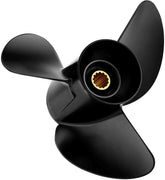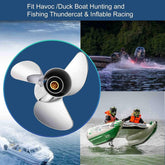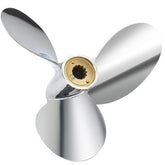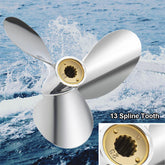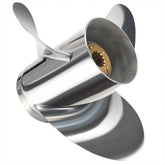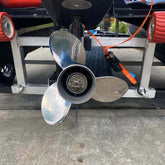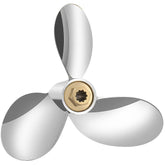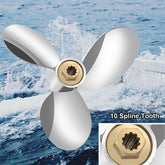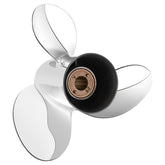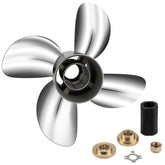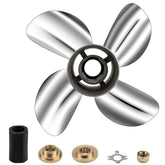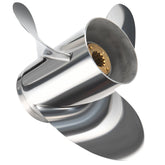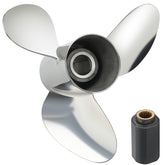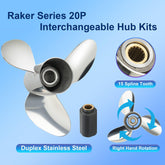Deck Boat vs Pontoon — Which Hull Matches Your Use?
Choosing between a deck boat and a pontoon is as much about how you spend your hours on the water as it is about hull lines. Both hull types have loyal followings, but they behave differently under load, in turns, during towing and when you fit different outboards and props. This article walks through the practical differences—how each hull rides, who gets the most from each platform, and how propeller choice (blade count, material and pitch) ties into real-world performance. Where useful, I draw on VIF’s product catalog (the product list you provided) to show how prop options line up with hull types and engine ranges up to 300 HP.
Deck boats and pontoons — the essentials

Design and hull geometry
Deck boats use a deep-V or modified-V hull with a broad, flared bow. That V-shape gives a deck boat more bite in a turn, better wave-cutting ability and generally a quicker, more responsive feel at speed. Pontoons use one or more cylindrical tubes (logs) underneath a flat deck. The result is enormous primary stability and a very different ride: predictable, stable and great for lounging, but lighter on carving and higher-speed handling.
Passenger layout and usable deck
Deck boats put a big emphasis on a cockpit that can handle both passengers and performance driving. Pontoons maximize usable flat deck area—perfect for large groups, sun pads and accessories like slide mounts or fishing stations. If group comfort and easy mobility on deck trump fast acceleration, pontoons win. If you plan to cut wakes, pull skiers or race the shoreline, a deck boat will usually feel more at home.
Stability, load and hauling
Under heavy loads a pontoon stays very level; deck boats can sit lower in the stern and change trim more noticeably with added people or fuel. That affects how the prop interacts with the water: heavy stern trim increases ventilation risk and may make the engine hunt for RPM. That’s why propeller selection and anti-ventilation features matter more on deck boats under heavy loads—and why pontoons often favor props that deliver reliable bite at lower speeds.
How the hull changes propeller priorities
Acceleration vs top speed
Deck boats are usually tuned toward a balance of acceleration and higher top speeds. That typically pushes owners toward three-blade props or high-performance stainless three-blades that favor speed and efficiency. Pontoons, loaded with passengers and gear, benefit from props that deliver grip and low-end thrust: this can be a higher-cupped 3-blade or a 4-blade that sacrifices a touch of top speed for much better hole-shot and steadier cruise under load.
Shaft location, gearcase and ventilation
On a deck boat, where the hull shape actively pushes the waterline and stern-squat dynamics, a prop that reclaims lost bite under changing trim becomes critical. Anti-ventilation plates and matched blade geometry help. Pontoons’ flatter transoms usually keep the prop submerged cleanly; the priority is steady thrust and resistance to line-wrapping and kelp—so line-catching hardware and prop guards are more common on pontoons used in debris-prone waters.
Towing and wakesports
If towing skiers or wakeboarders is part of the plan, look for props and engines that provide strong mid-range thrust and a predictable ramp into plane. Many pontoon owners who want water-sports capability pick higher-displacement/power outboards and tune prop pitch and blade count for maximum hole-shot. Deck-boat owners who prioritize speed may tune for less drag and finer top-end characteristics.
Practical hull-match guidance (use-case focused)
Social cruising, family days, entertaining — pontoon fits best

If your prime objective is carrying more people, having a stable platform, easy boarding and Yellowstone-level comfort, pontoons provide more real estate and comfort. Look for outboard setups that emphasize torque and slow-speed control. In VIF’s product matrix, the distribution of prop types shows strong coverage across the full HP range used by pontoons—VIF’s catalog includes a broad set of blades for Mercury and Yamaha outboards, and a high share of 3-blade and 4-blade options optimized for torque and low-end thrust.
Fast short-hop runs and shoreline cruising — deck boat fits best
If you want to get from A to B fast, enjoy cornering, and value sporty handling, deck boats fit the bill. Pick props that are optimized for speed and that match engine WOT RPM ranges so the engine runs in its sweet spot. In VIF’s listings, three-blade stainless options are well represented for mid- to high-HP outboards, giving the trim and prop characteristics sportier boats need.
Fishing and mixed-use — both can work with trade-offs
If you want a boat that fishes and carries the family, think about how you’ll balance boatspeed and low-speed control. A tritoon (3-log pontoon) gives extra buoyancy for heavy loads and can be fitted with props that provide good acceleration when you need it. Deck boats have better control in wind and chop and can be set up with GPS-trolling combinations or lower-pitch props for efficient cruise.
Propeller choice—how it maps to hull and function
Blade count: what the numbers mean on the water
-
Three-blade props are efficient at converting engine power to speed; they tend to produce higher top speed and improved fuel economy at cruise. They are often the go-to for deck boats and performance-focused setups.
-
Four-blade props trade a little top-end speed for stronger low-end thrust, better hole-shot and improved handling at lower speeds. That makes them attractive for pontoons, tritoons and heavily loaded deck boats that must plane quickly.
-
More blades (5 or more) are rare for recreational outboards but sometimes used for specialized needs (high-horsepower, heavy-displacement craft).
VIF’s catalog reflects these trends in numbers: within the Mercury aluminum sheet alone the product list contains many three-blade entries and a significant number of four-blade entries—evidence our product range supports both speed and torque-focused installations.
Material: stainless vs aluminum in the real world
-
Aluminum props cost less, are easier to repair (bend and hammer), and are often fine for recreational deck boats and casual pontoon owners.

-
Stainless steel is stiffer, yields better power transfer and small performance gains, and resists deformation — so it’s common on high-performance deck boats or pontoons fitted with higher-power outboards used for watersports.

VIF’s product files show strong offerings in both aluminum and stainless across Mercury and Yamaha families, so there’s a direct match between hull/purpose and material selection.
Pitch and diameter: tuning for trim and loading
Propeller pitch determines how far the boat moves forward per prop revolution in ideal water; diameter governs the disc area through which the prop pushes. A larger-diameter, lower-pitch prop tends to pull harder at low speeds—useful for heavy pontoons and tritoons—whereas a smaller-diameter, higher-pitch prop suits deck boats tuned for top speed. It’s always better to choose a prop that results in a WOT RPM that sits within the engine manufacturer’s recommended redline band.
If you have a Mercury outboard, VIF’s product matrix includes prop models that span the broad HP ranges common to both pontoons and deck boats, supporting choices from small outboards up to 300 HP.
How to read your needs like a pro (straightforward rules)
Know your primary activity first
If the boat is mostly hosting friends and family, prioritize stability and torque (pontoon-style thinking), then pick a 3- or 4-blade prop that favors low-end and mid-range. If you spend more time planning runs and racing the shoreline, prioritize top speed and go for three-blade, higher-pitch options.
Track WOT RPM and use it as a tuning tool
After you install a prop, note WOT RPM at level load. If WOT RPM is too low (overloaded), choose a lower pitch; if it’s too high (over-revving) choose a higher pitch. The goal is to land inside the engine maker’s recommended WOT band.
Lean on the prop blade count for ride mood
-
Want a firm hole-shot and towing stability? Move toward a 4-blade.
-
Want higher top speed and slightly better fuel efficiency? Lean to a 3-blade stainless.
The catalog you provided contains many models for both approaches; VIF supports cross-referencing by HP and lower-unit type so you can pick a blade count that matches both hull and engine.
Maintenance and field realities that change choice
Cavitation and ventilation are hull-sensitive
Deck boats that squat stern-down can cause the prop to ventilate; anti-vent plates and careful prop selection reduce this issue. Pontoons that remain level introduce less sudden ventilation, but weeds and lines are still real risks.
Strike repair and material tradeoffs
An aluminum prop that bends is often repairable; a stainless prop that chips or cracks usually requires replacement. Boats operating in shallow, debris-prone water—common for pontoon owners—will appreciate guards or baskets and the economics of aluminum unless they demand top performance.
Prop guards and baskets
If you run in crowded marinas or weed channels, consider line-catchers and guards. VIF’s product list covers accessories and prop variants for outboards commonly mounted on both deck boats and pontoons.
Real procurement checklist (fast, actionable)
-
Identify boat type and primary use (social cruise, fishing, tow-sports, performance runs).
-
Note engine make/model and WOT specs; get the engine’s recommended WOT RPM band.
-
From the product list, pick props matching your engine’s spline/shaft specs and HP range (VIF’s catalog includes coverage across Mercury, Yamaha and Suzuki models up through 300 HP).
-
Choose blade count by priority: 3-blade for speed/efficiency, 4-blade for low-end bite/loaded handling.
-
Select material: aluminum for cost/repairability, stainless for precision and long-term performance.
-
Fit guards or baskets if you run heavily debris-prone routes or operate a rental/fleet.
-
Test WOT RPM and adjust pitch if the engine doesn’t sit in its recommended band.
Short case scenarios you’ll recognize
-
A family who swapped a 3-blade aluminum for a cupped 3-blade with slightly larger diameter on their 90 HP pontoon found plane time improved with the same top speed—because the new prop reduced slip under load.
-
A performance-oriented deck-boat owner moved from aluminum 3-blade to stainless 3-blade and gained a noticeable two-to-three percent top-speed improvement and slightly better throttle response.
-
A party-pontoon operator fitting a 4-blade prop for their heavier tritoon got faster planing with a heavier payload and reduced complaints about sluggish hole-shot.
These are tactical changes that match hull expectations to practical prop characteristics and are supported by the range of options in VIF’s catalog.
If you still can’t decide: a compact pairing guide
-
Pure social cruise, heavy passenger load, shallow water: pontoon + 4-blade or high-diameter 3-blade (aluminum or stainless depending on budget).
-
Mixed fishing and family use, desire for occasional speed: tritoon or deck boat with a mid-pitch 3-blade that balances cruise and acceleration; consider quick-change or spare props.
-
Performance, carving, shoreline runs: deck boat + stainless 3-blade + pitch tuned for WOT band.
Final note on VIF product coverage and support

VIF’s catalog (the spreadsheet you shared) contains broad coverage across Mercury and Yamaha families as well as Suzuki and others. The listing shows extensive three-blade and four-blade offerings that match lower-unit families and HP ranges up to 300 HP, enabling straightforward pairing between hull intent and the prop geometry you need. If you want, I can generate a compact spec sheet that maps deck-boat and pontoon use cases to specific VIF model numbers (by HP band and lower-unit family) extracted from your product list—makes procurement and inventory decisions fast and repeatable.


